COPYRIGHT, PLEASE NOTE
All the material on this website is copyrighted to J-P Metsavainio, if not otherwise stated. Any content on this website may not be reproduced without the author’s permission.
BUY A MUSEUM QUALITY POSTER
BUY A POSTER:https://astroanarchy.zenfolio.com/
Tuesday, January 28, 2020
IC 1396 wide field, reprocessed
This was my first light image for my "new" imaging system and first light for the whole winter season 2019 -2020.
Image is now "deeper" and stars are much better resolved. I'm really happy, how well this old second hand Tokina AT-x 300mm f2.8 lens performs. Even the CCD-shell in Apogee Alta U16 camera is very large, over 36x36mm, image from the lens can cover the whole CCD. There are some coma at out most corners of the full frame image but nothing serious.
The imaging system is undersampled, it has a spatial resolution of 6 arc seconds / pixel. This makes the optical system very fast. The same Tokina lens with a small pixel CCD and spatial resolution of 1 arc second / pixel, is 36 times slower to capture light. That's a lot! One hour exposure with my current system is equal to 36 hours exposure with one that has tiny pixels.The lost of resolution is not really an issue, when I want to capture very faint and diffused nebula structures.
Info about my current imaging system can be seen here, https://astroanarchy.blogspot.com/2020/01/the-frankenstein-monster-my-current.html
IC 1396
Please, click for a full size photo it's worth it!
Image is in mapped colours, from the emission of ionized elements, R=Sulphur, G=Hydrogen and B=Oxygen. The signal for ionized oxygen. Note, at lower right corner shows a small part of Sharpless 129, Sh2-129. Some images of Sharpless 129 can be seen here, https://astroanarchy.blogspot.com/2018/11/a-giant-squid-ou4-imaging-project.html
An experimental starless version
Please, click for a full size photo
The planetary nebula candidate at middle left stands out well in this starless photo of IC 1396 area.
Planetary Nebula?
Please, click for a full size photo
Just left from the IC 1396 seems to be a circular formation with some weak O-III emission. Could this be a planetary nebula? My friend, Sabik Rasool, a planetary nebula enthusiast, Find out that this formation is a HII area discovered in 2015. This doesn't rule out, that this could be an ancient planetary nebula?
Please, click for a full size photo
IC 1396 spans hundreds of light years at distance of about 3000 light years in constellation Cepheus. The famous formation of glowing gases, the "Elephant's Trunk Nebula" can be seen at four o'clock position.
This is an active star formation region and it has several massive young stars inside it, coursing the ionization of elements of this emission nebula.
The Garnet Star and the suspected planetary nebula PM 1-333. When I published the first version of this image in Facebook, an other friend of mine, Jussi Kantola, pointed out, that near the Garnet Star lays the PM 1-333. More info about this interesting region can be seen here, https://massimo-cosmicjourney.blogspot.com/2009/09/garnet-star-and-suspected-planetary.html?fbclid=IwAR2dmttg1Q2NmualjjwEPYI1wY8jlUJLClbcHwXkk9xnm7Tvi0YFcaHVwT4
H-alpha, 12 x 600 s, binned 1x1 = 2 h
O-III, 6x 600 s, binned 2x2 = 1 h.
S-II, 3 x 600 s. binned 2x2 = 0,5 h
The Garnet Star and the suspected planetary nebula PM 1-333. When I published the first version of this image in Facebook, an other friend of mine, Jussi Kantola, pointed out, that near the Garnet Star lays the PM 1-333. More info about this interesting region can be seen here, https://massimo-cosmicjourney.blogspot.com/2009/09/garnet-star-and-suspected-planetary.html?fbclid=IwAR2dmttg1Q2NmualjjwEPYI1wY8jlUJLClbcHwXkk9xnm7Tvi0YFcaHVwT4
Technical details
Processing workflow
Image acquisition, MaxiDL v5.07.
Stacked and calibrated in CCDStack2.
Deconvolution with a CCDStack2 Positive Constraint, 33 iterations, added at 50% weight
Color combine in PS CS3
Levels and curves in PS CS3.
Imaging optics
Tokina AT-x f2.8 camera lens
Mount
10-micron 1000
Cameras and filters
Imaging camera Apogee Alta U16 and Apogee seven slot filter wheel
Guider camera, Lodestar x 2 and an old spotting scope of Meade LX200
Astrodon filters,
5nm H-alpha 3nm S-II and 3nm O-III
5nm H-alpha 3nm S-II and 3nm O-III
Total exposure time
H-alpha, 12 x 600 s, binned 1x1 = 2 h
O-III, 6x 600 s, binned 2x2 = 1 h.
S-II, 3 x 600 s. binned 2x2 = 0,5 h
Sunday, January 26, 2020
Deep in to my heart, IC 1805 in mapped colors
HST-palette separates emission areas nicely and it's visually pleasing. In visual palette emission from sulfur and hydrogen are both at red part of the spectrum. Emission from oxygen is greenish blue.
I made some testing with my new imaging system based on Tokina AT-x 300mm f2.8 camera lens.
The CCD I'm using has kind of large pixels, 9 microns, so I'm undersampled, the image scale is just over 6 arcseconds / pixel. Undersampling is not a bad thing when my targets are large and dim nebula complexes. This system collects photons very fast!
The CCD I'm using has kind of large pixels, 9 microns, so I'm undersampled, the image scale is just over 6 arcseconds / pixel. Undersampling is not a bad thing when my targets are large and dim nebula complexes. This system collects photons very fast!
I selected the Heart Nebula as a target since I have plenty of reference material for it. Another reason is interesting and rarely imaged area after the bright tip of the heart. There are some remnants of a supernova explosion. I was really thrilled, when I saw the final stack of 12 600s H-alpha light frames. (Equal to 2h of exposures) I never have seen so much background nebulae and details from this popular target.
The Heart Nebula, IC 1805
Please, click for a large image
C 1805 in mapped colors, from the emission of ionized elements,
R=Sulfur, G=Hydrogen and B=Oxygen. (Hubble Palette)
SUPERNOVA REMNANT 132.7+1.3 (HB3)
IC 1805 in visual palette
Please, click for a large image
Red emission of an ionized hydrogen (H-alpha) is dominating the scene. Image is in visual color palette from emission of an ionized hydrogen and oxygen. R=hydrogen, G=Oxygen and B=oxygen.
SNR
In this photo there is a large supernova remnant, marked as a white circle. I haven't seen any photos of it before. I must take more O-III exposures to see, if I'm able to pick up any signal from this supernova remnant.
Radio image of the area shows mostly signal from OB6
SNR 132.7+1.3 at upper right. Source and more information, http://galaxymap.org/drupal/node/103
IC 1805 H-alpha emission alone
Please, click for a large image
H-alpha emission, only two hours of exposures is enough for a very deep image. The combination of 300mm f2.8 camera optics and large 9 micron pixels makes this imaging system extremely hungry for photons. Image scale is just over 6 arcseconds / pixel. By using the drizzle stacking method with well dithered subframes I can avoid any square stars.
Technical details
Processing workflow
Image acquisition, MaxiDL v5.07.
Stacked and calibrated in CCDStack2.
Deconvolution with a CCDStack2 Positive Constraint, 33 iterations, added at 50% weight
Color combine in PS CS3
Levels and curves in PS CS3.
Imaging optics
Tokina AT-x 300mm f2.8 camera lens
Mount
10-micron 1000
Cameras and filters
Imaging camera Apogee Alta U16 and Apogee seven slot filter wheel
Guider camera, Lodestar x 2 and an old spotting scope of Meade LX200
Astrodon filters,
5nm H-alpha 3nm S-II and 3nm O-III
5nm H-alpha 3nm S-II and 3nm O-III
Total exposure time
H-alpha, 12 x 600 s, binned 1x1 = 2 h
O-III, 3x 600 s, binned 1x1 = 30 min..
S-II, 2x1200 s, binned 2x2 = 40 min.
O-III, 3x 600 s, binned 1x1 = 30 min..
S-II, 2x1200 s, binned 2x2 = 40 min.
Saturday, January 25, 2020
A deep view to the California Nebula in mapped colors
beautifully rounded stars.
The very same optics with a camera, that has a very small pixels, will give a resolution of around one arcsecond / pixel. With same optical configuration, 300mm f2.8, system that has spatial resolution of 1 arcsecond / pixel is 36 times slover, than same optics with large pixels and spatial resolution of 6 arcseconds / pixel.
California Nebula, a deep view to the NGC 1499
Please, click for a full size image
Image is in mapped colors, H-alpha = Green, S-II = red and O-III = Blue.
Image is in mapped colors, H-alpha = Green, S-II = red and O-III = Blue.
This is a very deep image, I haven't seen those extended shapes at upper right and around the brighter nebula before. I have published the same image in visual color palette, it can be seen here, https://astroanarchy.blogspot.com/2020/01/deep-view-to-california-nebula-ngc-1499.html
A closeup
Please, click for a full size image
A very good resolution for the 300mm camera lens
An experimental starless version
Please, click for a full size image
Various shapes in nebula are easier to see when stars are removed.
INFO
A closeup
Please, click for a full size image
A very good resolution for the 300mm camera lens
An experimental starless version
Please, click for a full size image
Various shapes in nebula are easier to see when stars are removed.
INFO
The California Nebula is an emission area located in constellation Perseus. It appears to resemble outlines of State of California on long exposure photographs, like this one. It has a very low surface brightness and it's very difficult to observe visually. Distance from my hometown Oulu, Finland, is about 1000 light years.
this image spans around five degrees horizontally. The Wikipedia article states, that the angular size is about 2,5 degrees (Five full Moons side by side) but as can be seen in this image, the actual size, with a dim outer parts, is much large.
H-alpha exposure alone
Please, click for a full size image
Technical details
Processing workflow
Image acquisition, MaxiDL v5.07.
Stacked and calibrated in CCDStack2.
Deconvolution with a CCDStack2 Positive Constraint, 33 iterations, added at 50% weight
Color combine in PS CS3
Levels and curves in PS CS3.
Imaging optics
Tokina AT-x 300mm f2.8 camera lens
Mount
10-micron 1000
Cameras, filters and guiding
Imaging camera Apogee Alta U16 and Apogee seven slot filter wheel
Guider camera, Lodestar x 2 and an old spotting scope of Meade LX200
Astrodon filters,
5nm H-alpha 3nm S-II and 3nm O-III
Total exposure time
H-alpha, 7 x 1200 s, binned 1x1 = 2 h 20 min.
O-III, 2x 1200 s, binned 2x2 = 40 min.
S-II, 2x1200 s binned 2x2 = 40 min.
The apparent scale in a sky
Please, click for a full size image
This is a large object
NOTE, the apparent size of the full moon is marked in all of the images above.
The angular dimension of the moon is 30 arcminutes, that's 0,5 degrees.
More info about this photo from the year 2012 here, https://astroanarchy.blogspot.com/2012/02/california-nebula-ngc-1499-with-some.html
Thursday, January 23, 2020
A deep view to the California Nebula, NGC 1499
beautifully rounded stars..
California Nebula, NGC 1499
Please, click for a full size image
Image is in natural colors combined from the narrowband channels. H-alpha = Red, O-III = Green and O-III + 20% H-alpha = Blue. This is a very deep image, I haven't seen those extended shapes at upper right and around the brighter nebula.
Image is in natural colors combined from the narrowband channels. H-alpha = Red, O-III = Green and O-III + 20% H-alpha = Blue. This is a very deep image, I haven't seen those extended shapes at upper right and around the brighter nebula.
INFO
The California Nebula is an emission area located in constellation Perseus. It appears to resemble outlines of State of California on long exposure photographs, like this one. It has a very low surface brightness and it's very difficult to observe visually. Distance from my hometown Oulu, Finland, is about 1000 light years.
this image spans around five degrees horizontally. The Wikipedia article states, that the angular size is about 2,5 degrees (Five full Moons side by side) but as can be seen in this image, the actual size, with a dim outer parts, is much large.
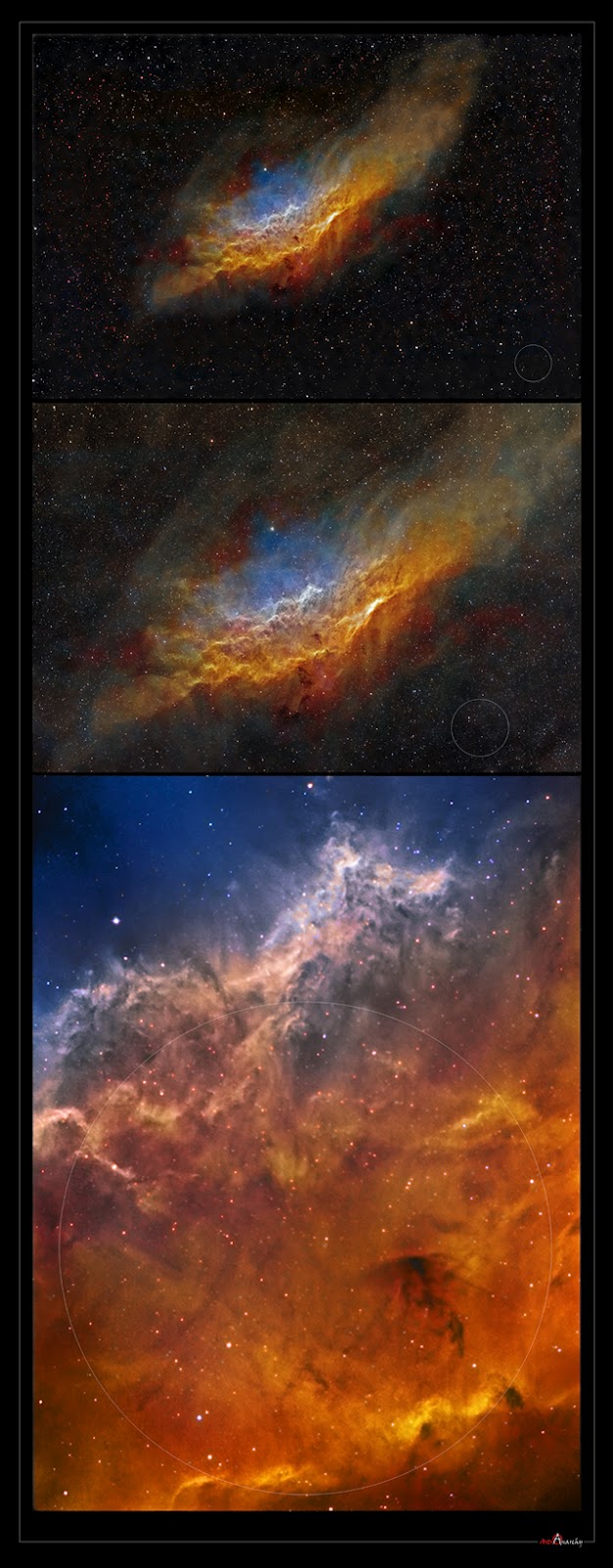
This is a large object, note, the size of the Moon is marked, as a scale, in all of the images above.
H-alpha exposure alone
Please, click for a full size image
H-alpha image contains seven 20 min sub exposures stacked together. Exposure time is 2h 20 min..
Technical details
Processing workflow
Image acquisition, MaxiDL v5.07.
Stacked and calibrated in CCDStack2.
Deconvolution with a CCDStack2 Positive Constraint, 33 iterations, added at 50% weight
Color combine in PS CS3
Levels and curves in PS CS3.
Imaging optics
Tokina AT-x 300mm f2.8 camera lens
Mount
10-micron 1000
Cameras, filters and guiding
Imaging camera Apogee Alta U16 and Apogee seven slot filter wheel
Guider camera, Lodestar x 2 and an old spotting scope of Meade LX200
Astrodon filters,
5nm H-alpha 3nm S-II and 3nm O-III
Total exposure time
H-alpha, 7 x 1200 s, binned 1x1 = 2 h 20 min.
O-III, 2x 1200 s, binned 2x2 = 40 min.
On older image of California nebula in mapped colors
The apparent scale in a sky
Please, click for a full size image

This is a large object, note, the size of the Moon is marked, as a scale, in all of the images above.
More info about his photo from the year 2012 here, https://astroanarchy.blogspot.com/2012/02/california-nebula-ngc-1499-with-some.html
Labels:
Narrowband color images,
nebula
Sunday, January 19, 2020
An animated Heart Nebula, IC1805 with and without stars
My "new" imaging system combines a Tokina AT-x 300mm f2.8 lens to a large CCD of Apogee Alta U16 astro camera with 4096x4096 9 micron pixels. This combination has a resolution of about 5 arc seconds/pixels. Undersampling imaging system is a great tool to bring out very dim and diffused nebulae very fast. This photo of Heart Nebula has only 2h of H-alpha light and just 30 min O-III light.
IC 1805 without stars
Please, click for a full size image
It's easier to see the actual nebula when stars are removed. Human brains has a tendency to form quasi logical shapes and forms from a random cloud of dots. Famous example of this phenomena is Percival Lowell and canals of Mars.
An animated image, IC 1805 with and without stars
Please, click for a full size image
Technical details
Processing workflow
Image acquisition, MaxiDL v5.07.
Stacked and calibrated in CCDStack2.
Deconvolution with a CCDStack2 Positive Constraint, 33 iterations, added at 50% weight
Color combine in PS CS3
Levels and curves in PS CS3.
Imaging optics
Tokina AT-x 300mm f2.8 camera lens
Mount
10-micron 1000
Cameras and filters
Imaging camera Apogee Alta U16 and Apogee seven slot filter wheel
Guider camera, Lodestar x 2 and an old spotting scope of Meade LX200
Astrodon filters,
5nm H-alpha 3nm S-II and 3nm O-III
5nm H-alpha 3nm S-II and 3nm O-III
Total exposure time
H-alpha, 12 x 600 s, binned 1x1 = 2 h
O-III, 3x 600 s, binned 1x1 = 30 min..
O-III, 3x 600 s, binned 1x1 = 30 min..
From Bubble to Cave Nebula in visual colors
At January 10. I shot few lights for this busy area in Cassiopeia from the Bubble Nebula to Cave nebula. The Tokina 300mm AT-x f2.8 camera lens combined to Apogee Alta U16 camera is a very good to capturing photons. The combination of fast f2.8 optics and 9 micron pixels, (4096 x 4096 pixels) goes very deep very fast. (First light photo here, https://astroanarchy.blogspot.com/2020/01/first-light-for-winter-season-2019-20.html)
From Bubble to Cave Nebula
Please, click for a large image!
Image is in visual palette combined from emissions of ionized elements. Red=H-alpha + S-II, Green= O-III and Blue=O-III + 25%H-alpha to compensate missing H-beta emission.
Same data in mapped colors can be seen here, https://astroanarchy.blogspot.com/2020/01/second-light-for-my-wide-field-imaging.html
H-alpha, 18 x 600 s, binned 1x1 = 2,5 h
O-III, 6x 600 s, binned 1x1 = 1 h.
S-II, 2 x 600 s. binned 1x1 = 20 min.
Same data in mapped colors can be seen here, https://astroanarchy.blogspot.com/2020/01/second-light-for-my-wide-field-imaging.html
Orientation
Please, click for a large image!
The area of the new photo is marked as a white rectangle. Info about this image here, https://astroanarchy.blogspot.com/2014/01/a-grande-finale-of-cepheus-project.html
Technical details
Processing workflow
Image acquisition, MaxiDL v5.07.
Stacked and calibrated in CCDStack2.
Deconvolution with a CCDStack2 Positive Constraint, 33 iterations, added at 50% weight
Color combine in PS CS3
Levels and curves in PS CS3.
Imaging optics
Tokina AT-x f2.8 camera lens
Mount
10-micron 1000
Cameras and filters
Imaging camera Apogee Alta U16 and Apogee seven slot filter wheel
Guider camera, Lodestar x 2 and an old spotting scope of Meade LX200
Astrodon filters,
5nm H-alpha 3nm S-II and 3nm O-III
5nm H-alpha 3nm S-II and 3nm O-III
Total exposure time
H-alpha, 18 x 600 s, binned 1x1 = 2,5 h
O-III, 6x 600 s, binned 1x1 = 1 h.
S-II, 2 x 600 s. binned 1x1 = 20 min.
Labels:
Narrowband color images,
nebula
Thursday, January 16, 2020
Deep view to IC 1396
IC 1396 in visual colors
Please, click for a large image
Red glow of an ionized hydrogen (H-alpha) is dominating the view, bluish hues at center are from an ionized oxygen (O-III). There is some very faint O-III emission visible at nine o'clock position, near the left edge. I can see some circular shape there as well. It might be a very dim and diffused planetary nebula, I must look into this later. It can be seen better in mapped color version of this photo, https://astroanarchy.blogspot.com/2020/01/first-light-for-winter-season-2019-20.html
INFO
H-alpha, 12 x 600 s, binned 1x1 = 2 h
O-III, 6x 600 s, binned 4x4 = 1 h.
S-II, 3 x 600 s. binned 4x4 = 0,5 h
INFO
IC 1396 spans hundreds of light years at distance of about 3000 light years in constellation Cepheus. The famous formation of glowing gases, the "Elephant's Trunk Nebula" can be seen at four o'clock position.
This is an active star formation region and it has several massive young stars inside it, coursing the ionization of elements of this emission nebula.
Technical details
Processing workflow
Image acquisition, MaxiDL v5.07.
Stacked and calibrated in CCDStack2.
Deconvolution with a CCDStack2 Positive Constraint, 33 iterations, added at 50% weight
Color combine in PS CS3
Levels and curves in PS CS3.
Imaging optics
Tokina AT-x f2.8 camera lens
Mount
10-micron 1000
Cameras and filters
Imaging camera Apogee Alta U16 and Apogee seven slot filter wheel
Guider camera, Lodestar x 2 and an old spotting scope of Meade LX200
Astrodon filters,
5nm H-alpha 3nm S-II and 3nm O-III
5nm H-alpha 3nm S-II and 3nm O-III
Total exposure time
H-alpha, 12 x 600 s, binned 1x1 = 2 h
O-III, 6x 600 s, binned 4x4 = 1 h.
S-II, 3 x 600 s. binned 4x4 = 0,5 h
Labels:
Narrowband color images,
nebula
Wednesday, January 15, 2020
Firework
I was imaging at December 31. Since my observatory locates at centrum of the city, there was lots of fireworks going on around. One of my 20 min sub frames captured a big one! Image was taken with a Tokina 300mm f2.8 camera lens, 5 nm H-alpha filter and Apogee Alta U16 astronomical camera.
FIREWORK
Click for a large image
H-alpha shot of firework looks kind of neat
Technical details
Processing workflow
Image acquisition, MaxiDL v5.07.
Calibrated in CCDStack2.
Levels and curves in PS CS3.
Imaging optics
Tokina AT-x 300mm f2.8 camera lens
Mount
10-micron 1000
Cameras and filters
Imaging camera Apogee Alta U16 and Apogee seven slot filter wheel
Guider camera, Lodestar x 2 and an old spotting scope of Meade LX200
Astrodon filters,
5nm H-alpha
5nm H-alpha
Total exposure time
H-alpha, 1 x 1200 s, binned 1x1 = 20 min.
Tuesday, January 14, 2020
Deep look to the Heart
I made some testing with my new imaging system based on Tokina AT-x 300mm f2.8 camera lens.
The CCD I'm using has kind of large pixels, 9 microns, so I'm undersampled, the image scale is almost 5 arc seconds / pixel. Undersampling is not a bad thing when my targets are large and dim nebula complexes. This system collects photons very fast!
The CCD I'm using has kind of large pixels, 9 microns, so I'm undersampled, the image scale is almost 5 arc seconds / pixel. Undersampling is not a bad thing when my targets are large and dim nebula complexes. This system collects photons very fast!
I selected the Heart Nebula as a target since I have plenty of reference material for it. Another reason is interesting and rarely imaged area after the bright tip of the heart. There are some remnants of a supernova explosion. I was really thrilled, when I saw the final stack of 12 600s H-alpha light frames. (Equal to 2h of exposures) I never have seen so much background nebulae and details from this popular target.
Beside 2h of H-alpha (Light from an ionized hydrogen) I shot 30 min of O-IIII (Light from an ionized Oxygen) To be able to make an image in visual palette.
The Heart Nebula, IC 1805
Please, click for a large image
Going very deep just in two hours! Image is in visual color palette from emission of an ionized hydrogen and oxygen. R=hydrogen, G=Oxygen and B=oxygen. I have made a starless version out of this image, it can be seen here, https://astroanarchy.blogspot.com/2020/01/an-animated-heart-nebula-ic1805805-with.html
An older image of the area from 2011
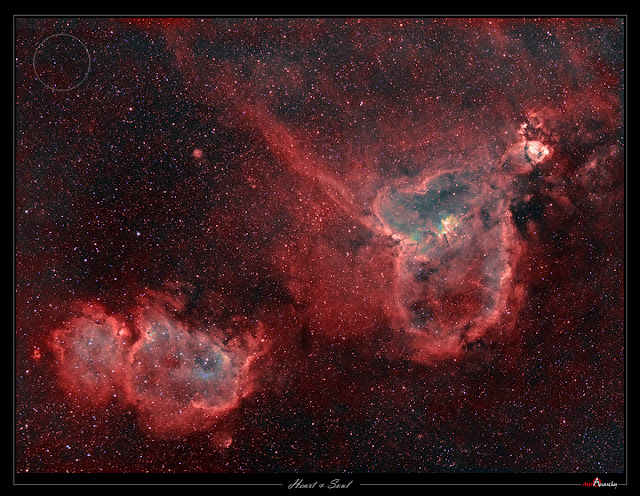
Note, there is a white circle showing an apparent size of the Moon at upper left corner to show the scale in the sky. More info about this older image can be seen here, https://astroanarchy.blogspot.com/2011/05/wide-field-vs-closeups-north-america_21.html
Technical details
Processing workflow
Image acquisition, MaxiDL v5.07.
Stacked and calibrated in CCDStack2.
Deconvolution with a CCDStack2 Positive Constraint, 33 iterations, added at 50% weight
Color combine in PS CS3
Levels and curves in PS CS3.
Imaging optics
Tokina AT-x 300mm f2.8 camera lens
Mount
10-micron 1000
Cameras and filters
Imaging camera Apogee Alta U16 and Apogee seven slot filter wheel
Guider camera, Lodestar x 2 and an old spotting scope of Meade LX200
Astrodon filters,
5nm H-alpha 3nm S-II and 3nm O-III
5nm H-alpha 3nm S-II and 3nm O-III
Total exposure time
H-alpha, 12 x 600 s, binned 1x1 = 2 h
O-III, 3x 600 s, binned 1x1 = 30 min..
O-III, 3x 600 s, binned 1x1 = 30 min..
Second light for my wide field imaging system
At January 10. I shot few lights for this busy area in Cassiopeia from the Bubble Nebula to Cave nebula. The Tokina 300mm AT-x f2.8 camera lens combined to Apogee Alta U16 camera is a very good to capturing photons. The combination of fast f2.8 optics and 9 micron pixels, (4096 x 4096 pixels) goes very deep very fast. (First light photo here, https://astroanarchy.blogspot.com/2020/01/first-light-for-winter-season-2019-20.html)
From Bubble to Cave Nebula
Please, click for a large image!
Image is in mapped colours, from the emission of ionized elements, R=Sulphur, G=Hydrogen and B=Oxygen. The signal for ionized oxygen,.
No Stars
Please, click for a large image!
Please, click for a large image!
An experimental starless image to show the actual nebula formation better.
Orientation
Please, click for a large image!
The area of the new photo is marked as a white rectangle. Info about this image here, https://astroanarchy.blogspot.com/2014/01/a-grande-finale-of-cepheus-project.html
Technical details
Processing workflow
Image acquisition, MaxiDL v5.07.
Stacked and calibrated in CCDStack2.
Deconvolution with a CCDStack2 Positive Constraint, 33 iterations, added at 50% weight
Color combine in PS CS3
Levels and curves in PS CS3.
Imaging optics
Tokina AT-x f2.8 camera lens
Mount
10-micron 1000
Cameras and filters
Imaging camera Apogee Alta U16 and Apogee seven slot filter wheel
Guider camera, Lodestar x 2 and an old spotting scope of Meade LX200
Astrodon filters,
5nm H-alpha 3nm S-II and 3nm O-III
5nm H-alpha 3nm S-II and 3nm O-III
Total exposure time
H-alpha, 18 x 600 s, binned 1x1 = 2,5 h
O-III, 6x 600 s, binned 1x1 = 1 h.
S-II, 2 x 600 s. binned 1x1 = 20 min.
Labels:
Narrowband color images,
nebula
Monday, January 13, 2020
The Frankenstein monster, my current imaging setup
First time at this Winter season 2019-20 I have a clear sky and somehow functional imaging system.
I managed to mate Apogee Alta U16 + filter wheel with my old second hand Tokina AT-x 300mm f2.8 camera lens.
Lots of self made mechanical tweaks was needed to make this work out.. (I used even an angle grinder to cut off ”unnecessary” parts of the lens to have correct back focus distance)
The result looks more like a Frankenstein monster. It’s alive!!!
"New" imaging setup
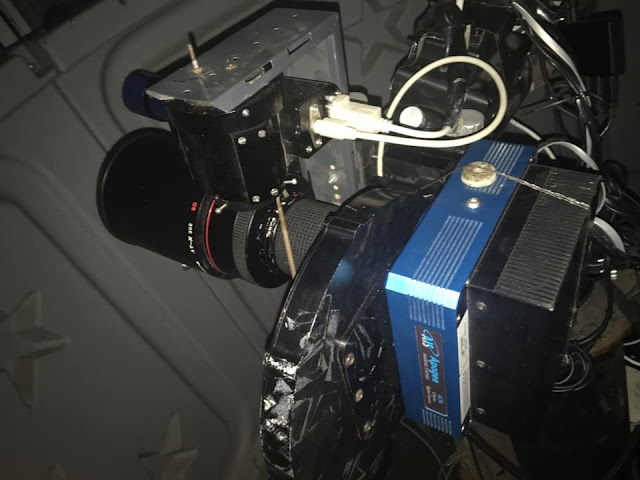
Apogee Alta U16 with a filter wheel and Tokina AT-x f2.8 camera lens n th 10-micron 1000 mount.
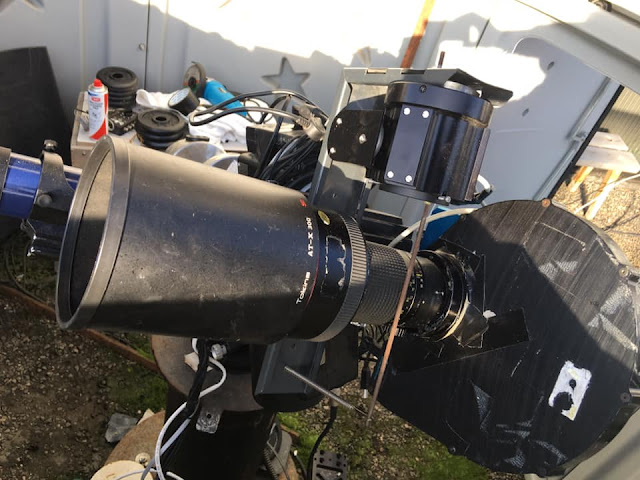
The focusing system is build around the TCF-s focuser. Focusing is done by a spring loaded round metal file over the focusing ring. This is a very accurate autofocusing system and it's temperature compensating too.
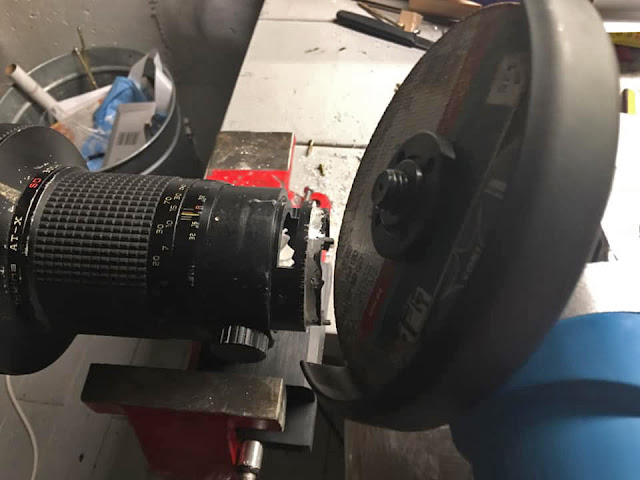
Shortening the lens, bajonet and aperture control ring are removed and I'm just about to cutting off the filter holder area. The current imaging system is kind of crazy combination. Actually it shouldn't work at all but with a angle grinder and self made adapter I was able to mate Tokina AT-x 300mm f2.8 optics to Apogee Alta U16 camera and filter wheel. There is also a temp compensating focusing system made from TCF-s focuser, L-shape metal from an old table, round metal file and a spring from an old desk lamp. The CCD is very large, over 36 x 36 mm but for some reason the lens can lit the whole area with a very little coma at most outer corners.
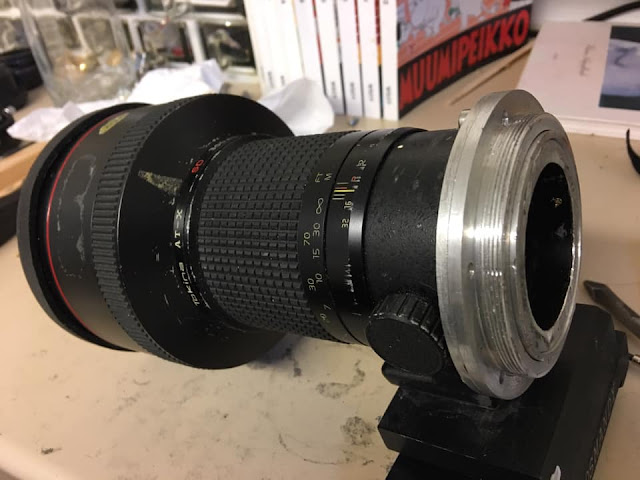
Self made adapter for the Apogee filter wheel attached.
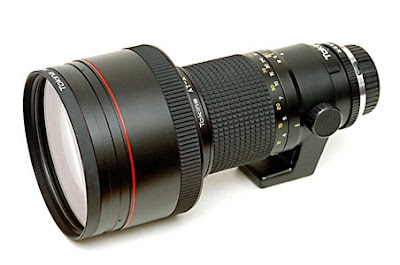
Original untouched lens.
First light photo for this system
Image analysis with CCDinspector
Click for a large image
This works way better than I thought! The whole oversize CCD is lit, there are some coma at corners but it'll be easy to crop out by removing narrow areas from left and right or from up and bottom.
Image of the full uncropped frame
(reduced 50% due to large size)
Image of the full uncropped frame
(reduced 50% due to large size)
Labels:
equipments,
Tokina 300mm f2.8 images
First light for the Winter season 2019-20, latest ever
I haven't post any new images since March 4. 2019, this is the first light for this Winter season!
I have had some technical problems with my "new" imaging system and the weather up here has been really bad for several months.
I have had some technical problems with my "new" imaging system and the weather up here has been really bad for several months.
The new imaging system is kind of temporary solution, since I'll have new camera and optical configuration in near future. The current system is interesting combination, a massive Apogee Alta U16 camera and filter wheel is mated with Tokina AT-x 2.8 camera lens. To make this combo to work, I had to modified the camera lens heavily. I cut a way part of the lens body with the angle grinder to have enough back focus distance. (I cut a way aperture control ring and filter holder part of the lens since they are not needed in astrophotography.) I'll post some pictures soon. EDIT, here are some info and images about this configuration
First light for the Winter 2019-20, IC 1396
Please, click for a full size photo
Image is in mapped colours, from the emission of ionized elements, R=Sulphur, G=Hydrogen and B=Oxygen. The signal for ionized oxygen,.
A close up
Please, click for a full size photo
Not a bad resolution for a 300mm camera lens!
There are a tiny planetary nebula PM 1-333 visible in this image, as a howk eyed Jussi Kantola pointed out in Facebook.
Not a bad resolution for a 300mm camera lens!
There are a tiny planetary nebula PM 1-333 visible in this image, as a howk eyed Jussi Kantola pointed out in Facebook.
Planetary Nebula?
Please, click for a full size photo
An experimental starless version
Please, click for a full size photo
The planetary nebula candidate at middle left stands out well in this starless photo of IC 1396 area.
INFO
H-alpha, 12 x 600 s, binned 1x1 = 2 h
O-III, 6x 600 s, binned 2x2 = 1 h.
S-II, 3 x 600 s. binned 2x2 = 0,5 h
Just left from the IC 1396 seems to be a circular formation with some weak O-III emission. Could this be a planetary nebula? I must check this soon from the astronomical database or if somebody knows this, please. let me know.
UPDATE!
UPDATE!
Ny friend Sabik Rasool, a planetary nebula enthusiast, Find out that this formation is a HII area discovered in 2015. This doesn't rule out, that this could be an ancient planetary nebula though.
An experimental starless version
Please, click for a full size photo
The planetary nebula candidate at middle left stands out well in this starless photo of IC 1396 area.
IC 1396 spans hundreds of light years at distance of about 3000 light years in constellation Cepheus. The famous formation of glowing gases, the "Elephant's Trunk Nebula" can be seen at four o'clock position.
This is an active star formation region and it has several massive young stars inside it, coursing the ionization of elements of this emission nebula.
Technical details
Processing workflow
Image acquisition, MaxiDL v5.07.
Stacked and calibrated in CCDStack2.
Deconvolution with a CCDStack2 Positive Constraint, 33 iterations, added at 50% weight
Color combine in PS CS3
Levels and curves in PS CS3.
Imaging optics
Tokina AT-x f2.8 camera lens
Mount
10-micron 1000
Cameras and filters
Imaging camera Apogee Alta U16 and Apogee seven slot filter wheel
Guider camera, Lodestar x 2 and an old spotting scope of Meade LX200
Astrodon filters,
5nm H-alpha 3nm S-II and 3nm O-III
5nm H-alpha 3nm S-II and 3nm O-III
Total exposure time
H-alpha, 12 x 600 s, binned 1x1 = 2 h
O-III, 6x 600 s, binned 2x2 = 1 h.
S-II, 3 x 600 s. binned 2x2 = 0,5 h
Labels:
Narrowband color images,
nebula
Subscribe to:
Comments (Atom)





































